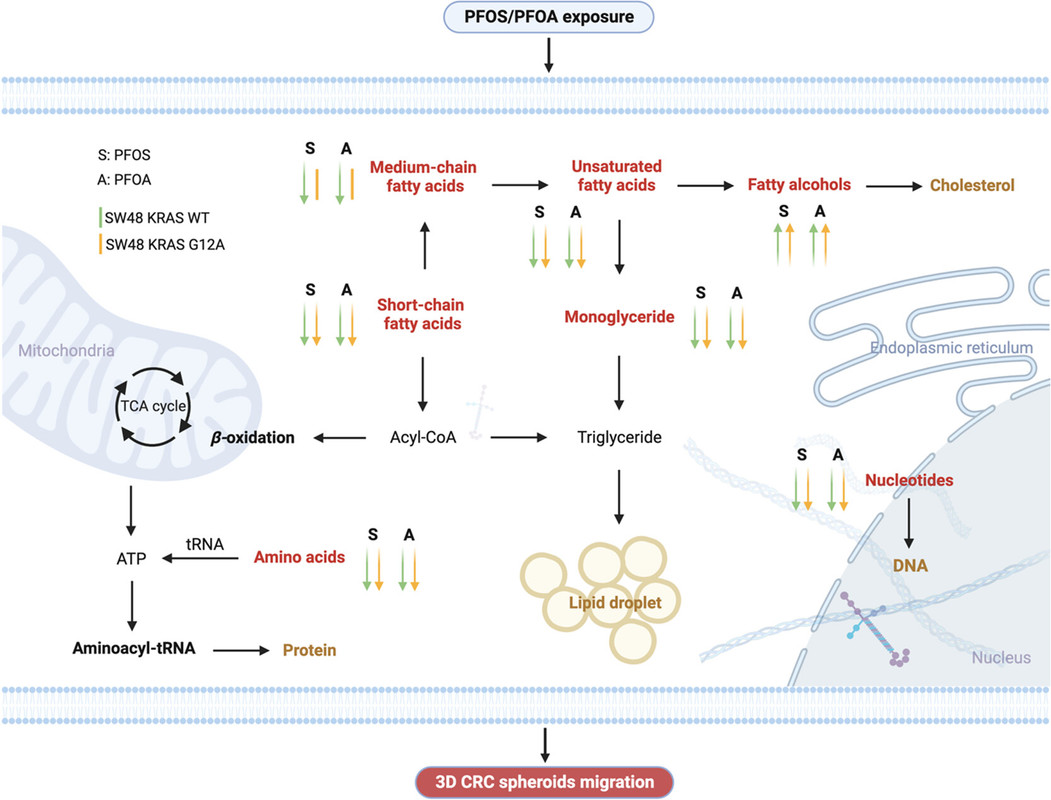Science
Related: About this forumThe Effect of PFAS on Colorectal Cancer: Some bad news.
Unfortunately I won't have much time to discuss this paper: Perfluorooctanesulfonic Acid and Perfluorooctanoic Acid Promote Migration of Three-Dimensional Colorectal Cancer Spheroids Jie Zheng, Boshi Sun, Domenica Berardi, Lingeng Lu, Hong Yan, Shujian Zheng, Oladimeji Aladelokun, Yangzhouyun Xie, Yujun Cai, Krystal J. Godri Pollitt, Sajid A. Khan, and Caroline H. Johnson
Environmental Science & Technology 2023 57 (50), 21016-21028.
PFAS are the class of compounds known a perfluoroalkyl substances, and they are ubitiquous on this planet, having been produced from products as widely used as teflon, upholstery as a fabric protector, in lubricants, and notably in AFFF (Aqueous Film Fighting Foam) used widely by firefighters both in training and in active fires. As I've noted in this space, the carbon fluorine bond is one of the strongest known, with a bond energy requiring far UV or higher frequency radiation to break the bond. They are, as described, in the text, as "forever chemicals."
From the text:
Colorectal cancer (CRC) is the third most common cancer and the second cause of cancer death in the world. (8) It is widely known that sporadic CRC frequently arises upon activation of oncogenes such as KRAS (Kirsten rat sarcoma viral oncogene), whose constitutive activation causes aberrant cell growth and promotes cancer metastasis. (9) The most frequent mutations in the KRAS gene are represented by point substitution in codons 12 and 13, which occur in approximately 35–45% of CRC. (10) Beyond its genetic etiology, CRC has been widely associated with environmental risk factors including, but not limited to, diet, alcohol consumption, tobacco smoking, obesity, and interaction with pathogens. (11) The relationship between PFAS exposure and CRC has been investigated only by a few studies. Consequently, there is currently a lack of knowledge about the underlying biological mechanisms of how exposure to PFAS can affect CRC development and progression.
In this regard, metabolomics is gaining interest in PFAS research to identify metabolites of PFAS exposure or biological effect, (12) which could be linked to mechanisms underlying CRC development or progression. Previous studies have shown a differential metabolic profile of CRC based on its tumor localization and across CRC stages I–IV. (13) Levels of specific amino acids (e.g., phenylalanine, valine), carboxylic acids (e.g., lactate), and lipids were shown to change from the early to the later and more aggressive stages of CRC with potential association with tumor metastases. Moreover, the presence of KRAS mutations in CRC was observed to be associated with suppressed expression of genes involved in immune pathways and suppression of iron-dependent cell death (i.e., ferroptosis). (14) To date, no studies have provided detailed profiling of metabolic pathways in CRC after PFOS and PFOA exposure, which is necessary to generate hypotheses regarding their toxicity mechanisms in CRC development and progression.
In this study, we observed that exposure to PFOS and PFOA at a dosage of 10 ?M can induce the migration of CRC spheroids of SW48 KRAS wild-type (WT) and KRAS G12A mutated cells. Initially, we evaluated the cytotoxic concentrations of PFOS and PFOA. Then, the migratory phenotype was analyzed through a wound healing and trans-well migration assay. Untargeted metabolomics was further performed, which revealed changes in fatty acids and amino acid metabolism in both SW48 KRAS WT and G12A cells after exposure to 10 ?M PFOS and PFOA. Finally, the hypothesis that PFOS and PFOA contribute to CRC metastasis was verified through the analysis of the expression of epithelial-mesenchymal transition (EMT)-related markers. In conclusion, this work provides insights into the metabolic response of CRC to PFAS exposure and provides evidence of their metastatic potential (Figure 1)...
The authors used cell lines from the most aggressive colorectal cancer lines for which no treatment is known, specifically cells with the KRAS mutation. (KRAS refers to a mutant gene originally found in an oncogenic virus in rats (Kirsten RAt Sarcoma virus), but now known to appear more generally in cancers.)
It is found that these cells tend to migrate in the presence of PFAS.
A graphic from the text:

The caption:
They identified populations at risk as being those who reside near airports, work on military reservations, firefighters, operators of incinerators, and workers at landfills.
Doubleplusungood. (Really, really, really bad news.)
I wish you a healthy and prosperous New Year.
WhiteTara
(29,722 posts)Last edited Mon Jan 1, 2024, 10:23 PM - Edit history (1)
... So whaddya bet those companies that make Teflon and all that other toxic crap knew of its dangers all along, but decided that their profits were more important than our lives.
What? Is my cynicism showing?
C'mon, guys. It wouldn't be the first time that happened. Hell, it wouldn't be the 500th time it happened. Do I hear 1,000th time?
Going... going... SOLD! To the sinister fellow in the shadows with the horde of lawyers on retainer.
LymphocyteLover
(5,654 posts)NNadir
(33,561 posts)I agree that one can always expand upon cell work, and one should do so, although there is a very active movement to minimize animal studies by substituting, beyond cells, tissues.
This said there is some epidemiological reference in the full paper describing - as alluded in my excerpt - to higher rates of CRC among people how have high levels of exposure to PFAS, notably firefighters with exposure to PFAS based AFFF.
If funded, it may be possible to compare CRC patients, particularly those with KRAS oncogenes for serum or plasma levels of PFAS with a control group.
There are many thousands of studies in the literature on PFAS levels in human and animal tissue.
LymphocyteLover
(5,654 posts)NNadir
(33,561 posts)I cannot of course copy the full paper, but you may access it if you wish and discuss your concerns with the authors.
If one enters the search term Cancer and PFAS in a search engine - I mostly use Google Scholar - one will see tens of thousands of hits.